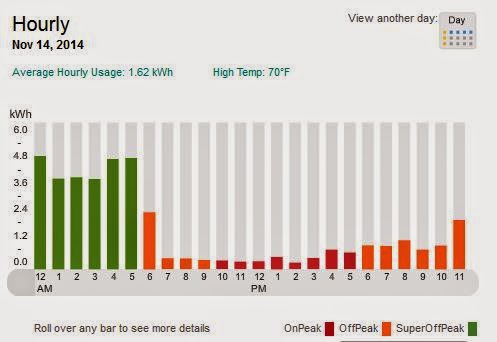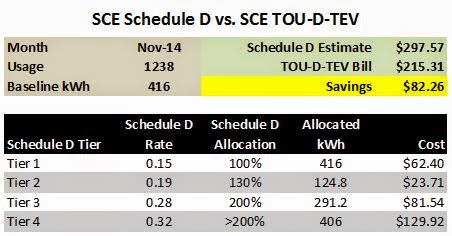TrojanEV
Active member
So I was quite surprised and disappointed to calculate that it is more affordable for me to charge at a Level 2 ChargePoint station at $1.25 per hour, than to charge at home under my Southern California Edison rate plan (or even their EV rate plans). Perhaps I only have myself to blame, since my home electrical usage seems to be on the high side (and thus pushing me into the expensive electrical tiers), but I also think So Cal Edison is not particularly EV-friendly. Here's how I did the calculations to arrive at my conclusion that it will be cheaper for me to charge using ChargePoint than charging at home:
First, let's start with what it would cost me to charge at home. I am currently on So Cal Edison's standard residential plan (Rate Plan D) and here is the price per tier (before any additional taxes):
Tier 1 Rate: $0.15 /kWh
Tier 2 Rate: $0.19 /kWh
Tier 3 Rate: $0.28 /kWh
Tier 4 Rate: $0.32 /kWh
For the last 12 months (before I owned an EV) my usage has always had us in Tier 3 or 4 (more Tier 4 than Tier 3). So adding my FFE charging to our residential plan, I will effectively be paying $0.28 to $0.32 /kWh to charge. With gas at $3.00 per gallon and using the basic rule of 10, it puts my equivalent cost about even with a gallon of gas. Not good.
Now let's look at ChargePoint. Thankfully I have a ChargePoint station about a block from my work so I can charge up there when I need it. If I charge using a ChargePoint Level 2 charger, it takes about 4 hours at $1.25 per hour, so $5 to charge my entire 23 kW battery. That comes out to $0.22 /kWh to charge with ChargePoint. Obviously I need to time my charging carefully, so I pay for (and receive) each full hour's worth of charge since I think ChargePoint charges in whole hour increments (e.g. 61 minutes of charging costs 2 hours) -- but in general, this seems like my preferred (although not particularly convenient) charging method.
So Cal Edison does offer an EV whole house rate plan, but personally, I think it's crap, and may actually cost heavy users like me more money than the standard residential plan. Yes, you get a cut-rate price ($0.09 to $0.10 /kWh) from midnight to 6am, but they just make up for it by charging you higher prices (as much as $0.49 /kWh) during the other time periods. The other option is to install a dedicated meter for EV charging but that isn't practical for me since I'm currently renting.
Thoughts? Do my calculations look correct? I'm telling myself the inconvenience is simply the cost of saving the world from fossil fuels, but I have to admit I'm already a bit frustrated by the experience. I was expecting the power companies to be a little more supportive.
First, let's start with what it would cost me to charge at home. I am currently on So Cal Edison's standard residential plan (Rate Plan D) and here is the price per tier (before any additional taxes):
Tier 1 Rate: $0.15 /kWh
Tier 2 Rate: $0.19 /kWh
Tier 3 Rate: $0.28 /kWh
Tier 4 Rate: $0.32 /kWh
For the last 12 months (before I owned an EV) my usage has always had us in Tier 3 or 4 (more Tier 4 than Tier 3). So adding my FFE charging to our residential plan, I will effectively be paying $0.28 to $0.32 /kWh to charge. With gas at $3.00 per gallon and using the basic rule of 10, it puts my equivalent cost about even with a gallon of gas. Not good.
Now let's look at ChargePoint. Thankfully I have a ChargePoint station about a block from my work so I can charge up there when I need it. If I charge using a ChargePoint Level 2 charger, it takes about 4 hours at $1.25 per hour, so $5 to charge my entire 23 kW battery. That comes out to $0.22 /kWh to charge with ChargePoint. Obviously I need to time my charging carefully, so I pay for (and receive) each full hour's worth of charge since I think ChargePoint charges in whole hour increments (e.g. 61 minutes of charging costs 2 hours) -- but in general, this seems like my preferred (although not particularly convenient) charging method.
So Cal Edison does offer an EV whole house rate plan, but personally, I think it's crap, and may actually cost heavy users like me more money than the standard residential plan. Yes, you get a cut-rate price ($0.09 to $0.10 /kWh) from midnight to 6am, but they just make up for it by charging you higher prices (as much as $0.49 /kWh) during the other time periods. The other option is to install a dedicated meter for EV charging but that isn't practical for me since I'm currently renting.
Thoughts? Do my calculations look correct? I'm telling myself the inconvenience is simply the cost of saving the world from fossil fuels, but I have to admit I'm already a bit frustrated by the experience. I was expecting the power companies to be a little more supportive.





































